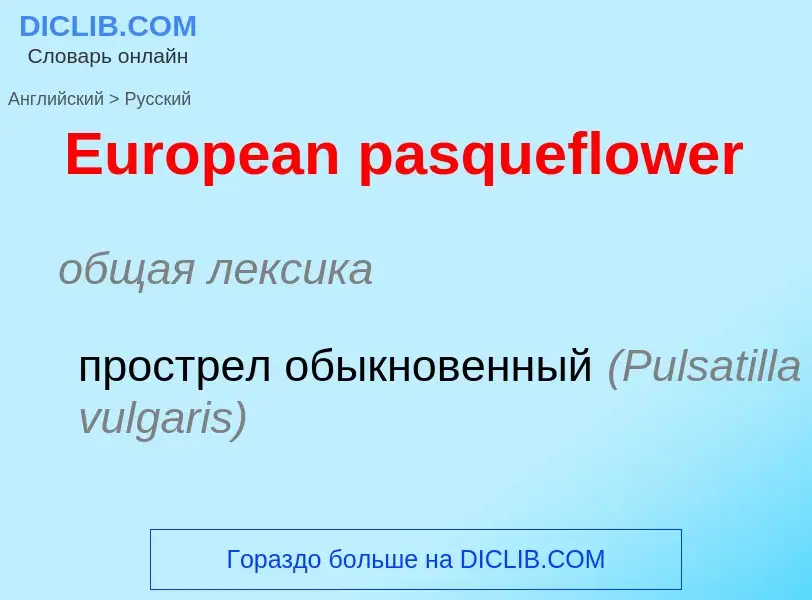Vertaling en analyse van woorden door kunstmatige intelligentie
Op deze pagina kunt u een gedetailleerde analyse krijgen van een woord of zin, geproduceerd met behulp van de beste kunstmatige intelligentietechnologie tot nu toe:
- hoe het woord wordt gebruikt
- gebruiksfrequentie
- het wordt vaker gebruikt in mondelinge of schriftelijke toespraken
- opties voor woordvertaling
- Gebruiksvoorbeelden (meerdere zinnen met vertaling)
- etymologie
European pasqueflower - vertaling naar russisch
общая лексика
прострел обыкновенный (Pulsatilla vulgaris)
Definitie
Wikipedia
 (17022184800).jpg?width=120)
Pulsatilla vulgaris, the pasqueflower, is a species of flowering plant belonging to the buttercup family (Ranunculaceae), found locally on calcareous grassland in Europe, and widely cultivated in gardens. It was considered part of the genus Anemone, to which it is closely related. Several sources still list Anemone pulsatilla as the accepted name, with Pulsatilla vulgaris as a synonym.
Other variations of its common name include European pasqueflower and common pasqueflower. The name may also be split in two - pasque flower.

 (17022184800).jpg?width=200)








![Dutch]]}} Dutch]]}}](https://commons.wikimedia.org/wiki/Special:FilePath/Americaslanguages (orthographic projection)-2.png?width=200)
![[[Franz Bopp]] was a pioneer in the field of comparative linguistic studies. [[Franz Bopp]] was a pioneer in the field of comparative linguistic studies.](https://commons.wikimedia.org/wiki/Special:FilePath/Franz Bopp (2).jpg?width=200)

![Scheme of Indo-European language dispersals from c. 4000 to 1000 BCE according to the widely held [[Kurgan hypothesis]].<br>– Center: Steppe cultures<br>1 (black): Anatolian languages (archaic PIE)<br>2 (black): Afanasievo culture (early PIE)<br>3 (black) Yamnaya culture expansion (Pontic-Caspian steppe, Danube Valley) (late PIE)<br>4A (black): Western Corded Ware<br>4B-C (blue & dark blue): Bell Beaker; adopted by Indo-European speakers<br>5A-B (red): Eastern Corded ware<br>5C (red): Sintashta (proto-Indo-Iranian)<br>6 (magenta): Andronovo<br>7A (purple): Indo-Aryans (Mittani)<br>7B (purple): Indo-Aryans (India)<br>[NN] (dark yellow): proto-Balto-Slavic<br>8 (grey): Greek<br>9 (yellow):Iranians<br>– [not drawn]: Armenian, expanding from western steppe Scheme of Indo-European language dispersals from c. 4000 to 1000 BCE according to the widely held [[Kurgan hypothesis]].<br>– Center: Steppe cultures<br>1 (black): Anatolian languages (archaic PIE)<br>2 (black): Afanasievo culture (early PIE)<br>3 (black) Yamnaya culture expansion (Pontic-Caspian steppe, Danube Valley) (late PIE)<br>4A (black): Western Corded Ware<br>4B-C (blue & dark blue): Bell Beaker; adopted by Indo-European speakers<br>5A-B (red): Eastern Corded ware<br>5C (red): Sintashta (proto-Indo-Iranian)<br>6 (magenta): Andronovo<br>7A (purple): Indo-Aryans (Mittani)<br>7B (purple): Indo-Aryans (India)<br>[NN] (dark yellow): proto-Balto-Slavic<br>8 (grey): Greek<br>9 (yellow):Iranians<br>– [not drawn]: Armenian, expanding from western steppe](https://commons.wikimedia.org/wiki/Special:FilePath/Indo-European expansions.jpg?width=200)


